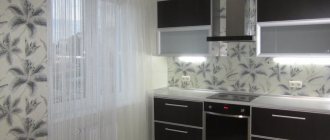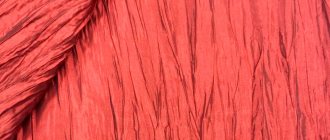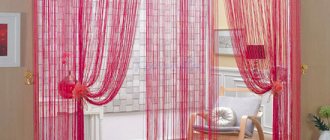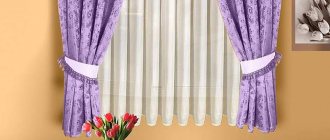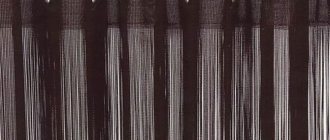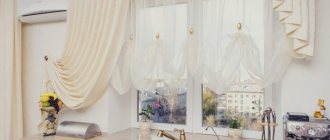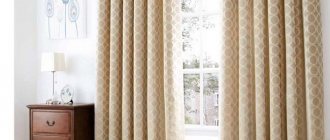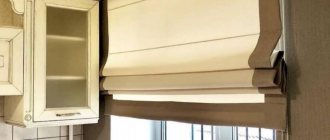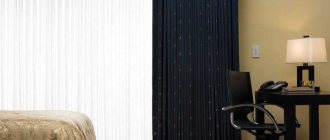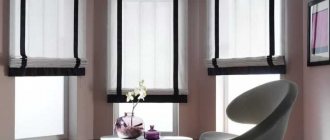Thread curtains are a decoration that no one will consider a mediocre window decoration. This is a light, delicate and magical window decoration. This type of curtain is also called muslin or thread curtain. This is one of the newest solutions in window design. They can be not only threads, but also combined with decorative elements, pebbles, bugles, beads and knots. Using thread curtains, you can create a three-dimensional image; you can change the threads in places, which, with different colors, will change the appearance of the window each time.
How to combine lambrequins and thread curtains?
Features of thread curtains
Despite its airy appearance, muslin perfectly protects the room from sunlight and overheating. Therefore, they are recommended for use in kitchens facing even the south.
From a constructive point of view, such curtains are very simple - they are many thin threads that are attached to a dense panel.
One of the advantages of muslin is the ability to use them not only as window curtains. If you wish, you can decorate the window opening with thread curtains or turn them into a partition.
The last technique is very convenient for zoning. For example, hang muslin to separate the dining area from the work area.
They often hang muslins in studio kitchens or kitchens combined with living rooms. This allows you to isolate the kitchen area from the room without visually overloading the room.
Kisey can separate the living room from the kitchen
Kiseys look good in kitchens with a balcony - thread curtains can reach both the windowsill and go down to the floor.
Kiseya separates the kitchen from the balcony
At the same time, the contrast in length does not kill their appearance, but, on the contrary, adds volume and makes them more interesting.
Why are string curtains in demand?
Light curtains resembling threads that allow air and sunlight to pass through are embodied in such qualities:
- window curtains;
- unique and cool decor;
- method of zoning rooms;
- separation of personal space in a common room.
This accessory can be purchased at the store or made yourself . There are both sliding and fixed models. Thread curtains come in a wide variety of options - they can be thread curtains, ribbon curtains, bead curtains, etc. Their common feature is that instead of a solid fabric, the curtain is assembled from separate flowing elements.
Advantages and disadvantages
Light muslin curtains are very popular. They have many advantages, but there are also disadvantages. Moreover, when used in the kitchen, the latter are quite significant. We recommend that you familiarize yourself with our table to make an informed decision whether muslin curtains are right for you.
As you can see, the disadvantages of thread curtains are quite conventional - if you hang them at a distance from heating appliances and make sure that there are no people in the house who want to play with them, muslins are perfect for use in the kitchen.
Types of muslin: what are they?
You should not think that all muslins look the same - simple threads attached to a thick piece of fabric. There are many types that allow you to choose the appropriate curtains for different types of kitchen interiors.
Kisey with thin threads
Narrow threads are perhaps the most popular type and are closest to traditional muslin. Thin threads made of artificial or natural material look very airy. This muslin is suitable both for a window in a small kitchen and for use as an interior partition.
Thin threads
If you choose the right shade, a thread curtain of this type will fit into any type of interior - from classic to high-tech.
Kisey with dense threads
Noodles are wide threads, more like thin ribbons. In a very small kitchen, such a muslin may seem cumbersome. However, it all depends on the thickness of the “noodles” - you can choose the appropriate option.
Kisey with dense threads
Please note that dirt on such curtains is more noticeable, which means you will have to wash them often. Especially if you decide to choose light colors.
Decorative muslins
Such muslin can look like a spiral, a fabric chain or a thick rope. They are quite capricious in interiors, so we recommend choosing such curtains after consulting a designer.
Thread curtains with a rain effect are created by adding lurex to the material. Soft overflows provide the effect of raindrops. The technique is very impressive, but they require some caution - they are not suitable for every kitchen design style.
Kisey with lurex
Various decorative elements can become a real decoration of the kitchen. Sequins, glass beads, and beads are used for this purpose. Recently, muslins with unusual elements - wooden beads, knots, feathers - have become popular.
Variants of muslin with glass beads
Such a thread curtain will cost you more than the usual option, but it will enliven the interior and will be ideal for a kitchen decorated in an ethno-style.
Colored muslins
Kiseys are also divided by color. You can choose either plain thread curtains or multi-color ones. The latter option is quite diverse, but one classic subspecies stands out in it - rainbow muslins, combining many shades. These curtains look best in a monochromatic kitchen, adding color to the interior and acting as a bright color accent.
Idea! Now muslins with pompoms are on sale. Soft balls made of thread or faux fur can add coziness and originality to the kitchen.
Harmony with style
Despite the versatility and tendency to combine rope (thread) curtains, they must be used with caution in certain interiors.
One of the most difficult styles to use for thread curtains is the classic one. She is predisposed to heavy and textured fabrics, luxurious ornaments and patterns. Kisey is light and airy and looks ridiculous among the splendor of Baroque and floral patterns of Provence.
But with a skillful and correct approach, you can get a harmonious and exclusive result. For example, by combining thread curtains and drapes with fringe or making drapery from threads in the form of classic swags.
The oriental style is naturally predisposed to the use of muslin in any of its forms. Lightness and mystery, enchanting motifs in the form of glass beads or a combination of bright colors, a thin and weightless veil on the way to a beautiful and amazing world.
The colorful and bright boho and primitive ethno styles are successfully combined with the “flowing” structure of the threads. Gusts of wind, the sound of rain and the slow passage of time are associated with the mysterious muslin.
In modern styles, thread curtains always look appropriate and harmonious. Solid minimalism is complemented by monochromatic products, mostly in white, gray or black shades. High-tech is more democratic and allows you to use beads, chains and lurex to decorate curtains. Silver thread curtains look great in an interior with modern elements of urban style.
How to hang muslin
In order for a thread curtain to hang smoothly and beautifully, it is important to hang it correctly. Regardless of what type of muslin you choose, we recommend using our instructions.
You can hang muslin in several different ways:
- Most modern thread curtains initially consist of threads and a border, with a pocket already provided for threading the curtain rod. In this case, you just need to carefully place the curtain on the curtain rod.
- If you want, you can fold the border in half and topstitch it. Then proceed as in the first case.
- To hang muslin on hooks, sew curtain braid to the border.
Threads can be tied in various ways.
It is very important to secure the muslin so that the threads do not get tangled in the process. Most manufacturers provide for this moment and tie them with tapes. In this case, carefully hang the muslin and only then remove the ribbons. If the curtain is sold without fasteners, then first unravel it, tie the threads and hang the curtain, then remove the fasteners.
Important! If you bought a muslin that is too long, don't worry. Just trim off the excess with scissors - the edges won't fray.
What to combine with
Kisey goes well with other types of curtains. The photo shows combinations with Roman, panel and roller blinds. They can also be combined with blinds and even curtains. Combinations with beads, sequins and various glass decorations are also popular. You can run threads of beads across the entire width, or decorate each thread with sequins.
Kisey and lambrequins
These curtains are absolutely universal, as we see in the photo, they can be combined with almost any other type of window decoration. But lambrequins occupy a special place. They can emphasize airiness, or they can “bring it down to earth.” Both interior elements do not have to be the same color; if the threads are monochromatic, then it is better that the top is the same color, but a darker shade.
Swags made from threads are also available for sale. You can make such semicircular lambrequins with your own hands. Their principle is to lay out the threads vertically in a semicircle. This option looks very exotic.
It is especially popular to use muslin in combination with rigid lambrequins. Such a lambrequin can be rectangular in shape, or you can give it any desired shape. They are great for creating an oriental style. The rigid lambrequin consists of two parts and tapers figuratively towards the middle, forming a dome of air. This design solution, combined with an oriental print, ornament or color, will immediately transport you to the atmosphere of a thousand and one nights.
Curtains with lambrequin
Curtains with lambrequins are at the peak of popularity again. They are suitable for decorating a variety of rooms, from the bedroom to the kitchen. Types of lambrequins can be very different.
Lambrequin is a special element of curtains that decorates the main curtain. It does not bear any functional load, except for hiding the cornice. It is often found when decorating windows in classic interiors, but recently you can often find curtains with a lambrequin in modern minimalist designs. Curtains complemented with such an element will give any room a slightly pompous and solemn appearance.
Not only heavy curtains, but also curtains can be decorated with a lambrequin. In this case, the curtain acts as a decoration, protecting neither from the sun nor from curious prying eyes.
Lambrequin can be made from various fabrics. Traditionally, lambrequins are made from heavy curtain materials or light chiffon, but in recent years various variations of materials have become increasingly common. They are often combined with each other, creating unique compositions.
You need to choose the right curtains with a lambrequin. Ideally, planning the entire design should begin with the understanding of whether such an element will be used when decorating the window space or not. Only by answering this question can you competently design a room, determine all the accents and nuances, and also choose the right fittings for the decor.
It is important to note that sometimes curtains with lambrequins are used not only for decorating windows. Sometimes this element is used when zoning a space when it is not possible to install a door. For example, arches or open openings can also be decorated with such curtains. If desired, they can be closed or opened, changing the appearance of the room.
Lambrequins allow the use of additional decorative elements along with them, for example, tiebacks. The main thing is to carefully ensure that the parts combine well with each other, both in design and color.
There are two large groups of lambrequins: soft and hard:
Rigid, or gang, can be matched to any style of interior. Usually they are a beautiful strip with a straight or figured cut that decorates the cornice. This can be fabric stretched over a wooden frame or non-woven fabric or other hard material (bando with a soft base). In modern interiors, openwork rigid lambrequins are often used , made using various techniques, including those made independently. Such a lace finishing element will not leave anyone indifferent. Thanks to a huge selection of different patterns and themes, you can choose the one that suits your room.
Hard lambrequins, including those with a carved pattern, are suitable for both rooms with low and high ceilings, which cannot be said about the next type - soft lambrequins. This type is only suitable for rooms whose ceiling height exceeds the standard 2.5 meters. Visually, the lambrequin “eats up” the height of the room, so you cannot install such decorations in rooms with low ceilings. Soft lambrequins are completely different. Firstly, they differ in the type of material. The most popular are satin lambrequins, as well as voile models. Both add solemnity to the room, but they do it in different ways.
Satin models create a very aristocratic look in the room, but they look quite heavy. They are often used when decorating windows in the living room:
Veil lambrequins look very airy and are suitable for decorating rooms such as a bedroom or children's room. Soft lambrequins also vary in shape. The mold is an element in the center of the top of the curtains. It consists of vertical folds that fold into an acute angle. Swags are the well-known arched folds.
De jabot, or jabot, is an asymmetrical element on the sides of the curtains. Jabot has a beveled corner. Typically, the long side points outward and the short side points toward the center. Tie , unlike De Jabot, is not such a wide side element. If the folds of the jabot are distributed vertically, then the tie is folded like an accordion with the short side outward. The bell is a fabric folded into a cone. This type of decoration is not used often, since it is made mainly from rigid curtain fabric that holds its shape well.
Today there are no color restrictions; the choice is huge:
The most popular colors for decorating a living room lambrequin are burgundy, beige, brown, pink, steel with a silver tint, and gold. This choice is characterized by the fact that guests are usually received in the living room, therefore, the furnishings should make an impression.
For the bedroom choose “cozy” colors: peach, beige, pink, green. Lilac lambrequins are also not uncommon, but this color should be treated with caution: it is not so easy to combine with the rest of the range of shades.
For the kitchen, lambrequins are usually chosen to match the color of the drapes or curtains. Most often these are pink, red, orange tones, but green, purple and even black are also found. It is popular to use fabric with a pattern to make lambrequins for the kitchen. Checkered or floral patterns lift your spirits and improve your appetite. More and more often, designers are resorting to using two or three colors when designing lambrequins. These can be either related tones or contrasting ones.
The choice in favor of multi-color models is quite justified by the fact that they look much more interesting than their monochromatic counterparts, while at the same time helping to make the curtains the semantic center of the entire composition.
Many people are afraid to choose multi-colored rigid lambrequins, but in vain. They look impressive and interesting even in classic interiors. By choosing a discreet pattern that repeats the furniture upholstery pattern, you can make the interior very stylish. Openwork lambrequins are mainly made of fabric without a pattern, so as not to overload the carved structure with unnecessary details. However, no one prohibits the use of gradient fabrics or the now popular chameleon fabric, which changes color depending on the angle of view.
When choosing a lambrequin, you need to focus on the style solution, the functional purpose, and the size of the room:
The hall is characterized by the choice in favor of combined lambrequins, combining both hard and soft elements. They look luxurious, instantly attracting attention. When choosing a lambrequin for the living room, they usually adhere to the rule in colors that the lambrequin should be a similar shade to the curtains, but not repeat it exactly.
For example, brown curtains, a brown hard lambrequin and beige soft swags are an excellent combination that does not look pretentious, but adds gloss to the room.
Both hard and soft lambrequins are installed in the bedroom, but never or very rarely together. The choice of model is determined by the height of the ceiling and the style of the room. As mentioned above, a hard lambrequin is suitable for installation under a ceiling of any height, while a soft one is only suitable for large rooms. If night curtains are used, it is better to choose soft contrasting lambrequins; When installing blinds or blackout curtains, a bandeau will fit perfectly into the interior. The style of the bedroom also plays a significant role. In this room you need to fully adhere to the rules prescribed by the style. So, when decorating in a modern style such as Loft, Modern, High-tech, you need to choose a rigid lambrequin. Baroque , Rococo, Art Deco and so on styles should be complemented by soft lambrequin models.
Blackout is a horizontal panel curtain that absorbs light almost completely.
For the kitchen, choose a simple soft lambrequin without any decorations such as swags or ties. The simpler the better. Curtains in the kitchen are subject to frequent washing, so it will not be possible to properly care for the lambrequin; it will quickly lose its shape and appearance. For the same reason, gangs are not suitable for a kitchen area. Under the influence of heat, they become deformed, and it will be impossible to remove greasy deposits from the fabric.
Of particular interest is the choice of design for a small room. Openwork gangs will be an excellent solution, as they will add elegance and airiness to the room, and will also help to visually expand the space. Under no circumstances should heavy satin lambrequins be installed in such a room. They will look ridiculous and vulgar. If you really want to hang exquisite soft swags, choose tulle. It looks airy and light.
Keep in mind that all soft lambrequins “eat up” space in one way or another, so an already small room will seem even smaller.
If you have drawn up the interior design in advance, there should be no problems with the choice. However, if the desire to hang a bandeau arises suddenly, problems may arise. In this case, keep a few recommendations in mind:
The simplest thing you can do is buy a ready-made set of curtains with a lambrequin. There is no need to rack your brains over a solution, since professional designers have already thought through both the color combination and the shape. However, if your window is not typical, this type of curtain is unlikely to suit you. Beautiful proportional lambrequins should not occupy more than 1/5 of the entire length of the curtain. Otherwise, the entire structure will look overly loaded. If you can’t make a choice, the best option would be a bandeau with an openwork pattern. They frame both short and long curtains well. Choosing a tulle lambrequin is a good solution not only for curtains. A light veil also fits well on dense materials, allowing you to visually lighten the overall appearance of such curtains.
Curtains with an asymmetrical lambrequin such as a jabot or a tie are ideal for the kitchen . If part of the window is planned to be covered with furniture, it is better to install such decoration on the opposite side of the window and only one. This way you can balance and decorate it, creating an unusual composition. When planning a lambrequin for 2 windows, which would combine them into a single whole, you can hang a mold over the sides of each frame. They will visually help to simultaneously separate the windows and unite them, creating a dramatic, festive effect. If you cannot decide on the choice of fabric for sewing lambrequins, we advise you to buy a small piece (about 20x20 cm) of each of the materials you like. Very often, consultants will accommodate you and provide such samples for free. Bring them home and take a good look at them in the room where you are planning window treatments. At arm's length in the direction of the window, evaluate each of the pieces, imagine how they will look when illuminated in this particular room. Apply the scraps to the curtains and evaluate which one matches them best.
This way you can save yourself from unnecessary expenses by easily choosing the only material you need.
Each type of lambrequin requires its own fastening technology:
Rigid gangs are usually made with Velcro and attached directly to the cornice.
Typically, lambrequins are mounted separately on the cornice in front of the main curtain. When purchasing curtains with curtains, you should order a triple baguette cornice: light curtains are hung behind everything, curtains are hung in the middle, and a lambrequin is closest to the room. Soft curtain lambrequins do not require separate fastening, since they are already sewn to the curtains.
Lambrequins on one side are usually attached in the same way as regular ones, except that you need to install a lock in the middle of the window. He will not allow the lambrequin to “move” from its assigned place.
beautiful jabots or ties on the sides with clamps that will secure their position on the cornice. If your room does not have a baguette cornice, but a tubular one, think about buying a lambrequin with eyelets. It can be hung immediately with the curtain fabric, decorating the top fold and drawing the viewer’s attention to the cornice, which is unusual for modern homes. The lambrequin puff is made on a curtain strip, which then needs to be gathered into even folds and hung on the cornice. Typically, curtain tape is attached using ring hooks, so you need to carefully ensure that the distance between the folds, as well as their size, is the same.
A lambrequin made of thread curtains is usually a cross-over design. All that is required is to throw it over the tubular cornice. Please note that a baguette cornice is not suitable for attaching such a lambrequin.
Caring for lambrequins usually does not cause any difficulties. All you need to do is simply vacuum the folds on a regular basis to prevent dirt from becoming embedded in the fabric. From time to time you should dry-clean your lambrequins.
Soft lambrequins should be vacuumed at minimum power, after wrapping the tube with damp gauze. It is forbidden to wet hard bandeaus; they may lose their shape and the material may swell.
Below are options for how you can use various modern models in the interior with a brief explanation of one or another solution:
A muslin thread lambrequin perfectly frames the head of the bed. This option looks elegant and adds chic to the bedroom. Using lambrequins with embroidery or appliqué is a great option for a nursery. This interior design looks very cute and interesting. Children will certainly love this window frame.
New items on the curtain market appear regularly. In particular, one of the discoveries of recent years has been the openwork bandeau, which fits perfectly into any interior. Two-color curtains and this detail are in perfect harmony with each other. Decorating the room in the form of a flower serves as the final touch to the composition. The interior of this bedroom uses both soft options and hard bandeaus. Using a soft model, the bed area is emphasized, and rigid wide bandeaus with a figured edge perfectly frame the window spaces. Separately, it is worth paying attention to the fact that the bedspread is made of the same fabric as the curtains above it. This gives the entire interior more style and harmony. You can use a complex lambrequin in the design of curtains for the bedroom. For its manufacture, a fashionable fabric with a gradient was chosen, which looks very solemn, immediately bringing to mind thoughts of royal chambers.
Tulle lambrequins can refresh the look of any room, giving it a slightly dreamy look. This white living room looks a little fairy-tale but grand at the same time. Simple swags are not supplemented with any elements, which only benefits the overall appearance of the room. If the designer had overloaded them with additional details, the overall impression of airiness would have been lost. Curtains and lambrequins do not have to be made using the same pattern. Here, roller blinds differ in ornamentation, however, lambrequins, curtains, and drapes echo the general elements of decoration both in color and pattern on the fabric. In this case, decorative sofa pillows are used as a connecting link.
In the next video, watch a master class on draping a swag lambrequin.
Thread curtains: 55 stylish ideas for muslin in the interior
Thin threads framing a large window or doorway look interesting, a little fabulous and, of course, beautiful
Thread curtains as a design element for a window opening or curtains for a bay window can be found quite rarely. This is due to the misconception about the inability of such curtains to shade the room. In fact, muslin perfectly copes with all the functions assigned to window curtains, and is also used as a space divider and a decorative interior detail. For example, hanging curtains on the doors will create an atmosphere of intimacy and lightness.
Content:
Thread curtains came to us from the East and today are very popular in European countries
Kisey in a modern interior
Thread curtains fit perfectly into the design of a children's room and delight children
How to care
Guinness is much easier to care for than regular curtains. They do not attract dust and dirt, so they require cleaning less often. The easiest way to freshen muslin is to take it to the dry cleaner. If you want to wash it yourself, use our recommendations:
- It is very important to prevent the threads from tangling. To do this, you need to tie them into several strands and secure them with ropes or ribbons. You can do this: tie the curtains with a rope along the entire length. For regular threads, take a step of 12-15 centimeters; for those decorated with beads or beads, reduce it to 6-8 centimeters. Then follow the instructions.
- After this, remove the curtain and place it in a laundry bag (it can be replaced with ordinary nylon tights).
- Wash the curtain in a washing machine on a delicate cycle or by hand.
- Hang it in place and remove the ropes - the curtain will straighten under its own weight, so you do not need to specially dry it and iron it.
Kisey in the kitchen interior
It would be a mistake to believe that muslins can look solely like threads suspended from the canvas, even if decorated. We invite you to look at a photo selection of interesting solutions that will inspire you to decorate your own kitchen.
Short muslin
Now short muslins, hung in several layers, are in fashion. In this way you can create an original and unusual curtain. For example, in the form of matches.
Short muslin
For this window decor, choose several multi-colored thread curtains ending with small pom-poms. Of course, such muslin is not suitable for classic interiors. But for modern people it’s fine.
Thin translucent muslin
Very thin translucent black or white muslin will become a real decoration for panoramic windows. Choose them if the kitchen faces north or west - otherwise they will not provide reliable protection from sunlight.
This technique is also well suited for small kitchens - muslin looks weightless, takes up virtually no space and visually enlarges the room.
Openwork muslin
A rather expensive option is openwork muslin with a rain effect. The threads are selected by hand, and the arrangement of lurex inserts in a certain order allows you to give the curtain not only the characteristic shine of raindrops, but also the illusion of lace.
Lurex inserts create the illusion of raindrops
Such curtains look good on high floor-to-ceiling windows, balcony doors or as interior partitions. They fit classic interiors and look very expensive and elegant.
Combined muslins
A stylish solution is combined muslins. Try pairing plain threads with embellished beads.
Beads decorate muslin without weighing it down
Such curtains look good on high floor-to-ceiling windows, balcony doors or as interior partitions. They fit classic interiors and look very expensive and elegant.
Kisey on knitted canvas
Such muslins also look very interesting. It is better if the threads are not located close to each other.
Kisey on knitted canvas
Such curtains are unlikely to protect you from the sun. But as decoration they can be a good move. Especially if you are planning a kitchen in the interest of shabby chic or boho.
Using volumetric elements
Sometimes rather voluminous elements are used as decoration - medallions, coins, knitted flowers. In this case, the base of the muslin should be as thin as possible - use light, airy threads.
Using a knitted flower
Keep the rest of the kitchen interior discreet - an abundance of decorative items will turn it from a stylish room into kitsch.
Combination with other elements
One of the main advantages of filament curtains is the ability to combine them with other materials. Kisey looks advantageous with tulle and other light fabrics.
Kisey contrasts with curtains
Combination of thin muslin with thick fabric
Threads can play the role of a base, and fabric curtains can be draped in the form of a lambrequin. Or, on the contrary, muslin can become a light decoration for denser material.
Modern idea! Sometimes full-length ropes act as muslin. They perform rather a decorative function, without protecting from sunlight. On the other hand, for interiors in loft or industrial style, such curtains can be a wonderful find, complementing the overall design of the kitchen.
Drapery
The drapery of filament curtains plays an important role. Here the possibilities for your imagination are practically unlimited. Experiment with shapes and color selections - you may be able to create a real designer masterpiece.
Black and white muslin with drapery
Black and white muslin looks very impressive, where threads of one color hang freely, and the other color diverges in directions opposite from the center. This technique visually expands the kitchen - take this into account when planning your curtain design.
This option visually expands the space
If you hang muslin in two layers, you can make something like a lambrequin or original drapery from the outer one. Use similar colors or, conversely, contrasting colors - a plain curtain in this design looks a bit boring.
Two-layer muslin with a complex weave of threads
The complex weave of threads looks impressive, but does little to protect you from sunlight. If the kitchen faces south or east, it is better to abandon this idea and think about a thicker curtain.
There are other ways to drape muslin - experiment using the following photos for inspiration.
Kinds
There are several ways to decorate thread curtains:
- Kiseya. Made from colored cotton threads. It can be not only plain, but also with patterns, decorated with lurex, bugles and beads.
- With beads. It consists of beads of different sizes and configurations strung on threads, which can be arranged in some sequence or randomly. Such curtains are suitable for simple interior styles - ethnic, bohemian, etc.
- Solid. They look like regular thread curtains, but are made from solid materials. They can be decorated with beads, beads, and stones.
- Rope curtains. They are made from viscose, polyester, lurex and acetate fabric. They come not only in the form of freely hanging threads, but also in the form of vertical blinds. They can also be decorated with beads and rhinestones.
It is recommended to choose thread curtains taking into account the characteristics of the room (area, lighting, color scheme). For a sunny room you can choose dark curtains, for a nursery - bright colors. Thread curtains can be multi-layered, which are suitable for a classic interior. Plain curtains with metal decorations will fit into the high-tech style.
